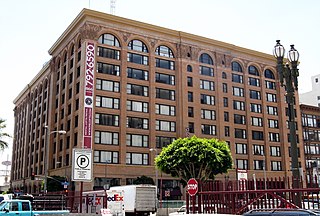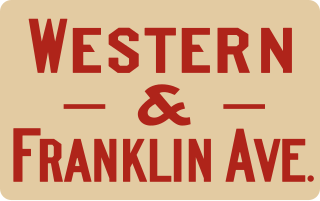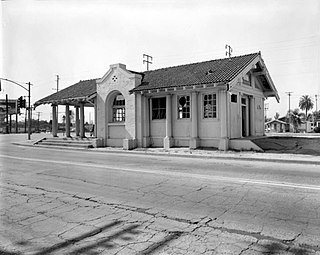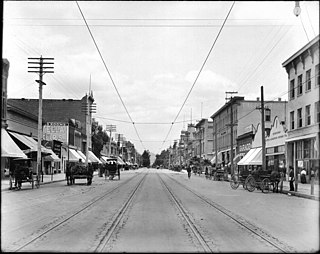
The Pacific Electric Railway Company, nicknamed the Red Cars, was a privately owned mass transit system in Southern California consisting of electrically powered streetcars, interurban cars, and buses and was the largest electric railway system in the world in the 1920s. Organized around the city centers of Los Angeles and San Bernardino, it connected cities in Los Angeles County, Orange County, San Bernardino County and Riverside County.

The historic Pacific Electric Building, opened in 1905 in the core of Los Angeles as the main train station for the Pacific Electric Railway, as well as the company's headquarters; Main Street Station served passengers boarding trains for the south and east of Southern California. The building was designed by architect Thornton Fitzhugh. Though not the tallest in Los Angeles, its ten floors enclosed the greatest number of square feet in any building west of Chicago for many decades. Above the train station, covering the lower floors, were five floors of offices; and in the top three was the Jonathan Club, one of the city's leading businessmen's clubs introduced by magnates from the Northeast. After the “Great Merger” of Pacific Electric into Southern Pacific Railroad in 1911, the PE Building became the home of Southern Pacific in Los Angeles. In 1925, a second electric rail hub, the Subway Terminal, was opened near Pershing Square to serve the north and west.

The Pasadena Short Line was a passenger railway line of the Pacific Electric Railway. It ran between Downtown Los Angeles and Downtown Pasadena, California, through Eastside Los Angeles along the foot of the eastern San Rafael Hills to the western San Gabriel Valley. It was in service under the company between 1902 until 1951, though it had operated under different companies back to its beginnings as a horsecar line. The route, designated by the company as line 2, was the key component of the company's Northern Subdivision.

The Balboa Line was the southernmost route of the Pacific Electric Railway. It ran between Downtown Los Angeles and the Balboa Peninsula in Orange County by way of North Long Beach, though the route was later cut back to the Newport Dock. It was designated as route 17.

The Owensmouth Line was a Pacific Electric interurban service that connected the San Fernando Valley to Downtown Los Angeles. The route was largely developed as the result of real estate speculation.

The Whittier Line was a Pacific Electric interurban line which traveled between Los Angeles and Whittier via Huntington Park, Rivera, and Los Nietos. A branch of the company's original Long Beach Line, operations along the line began in 1903. Due to its indirect route, passenger operations were eventually replaced by bus service on Whittier Boulevard after 1938. Tracks were largely retained for use by freight trains, eventually becoming the Union Pacific La Habra Subdivision. A short segment of the route is expected to be reactivated for passenger service as part of the Southeast Gateway Line.

The West Santa Ana Branch is a rail right-of-way formerly used by the Pacific Electric's (PE) Santa Ana route in Los Angeles County and Orange County in Southern California. The Los Angeles County Metropolitan Transportation Authority (Metro) owns the segment of the right-of-way in Los Angeles County, and the Orange County Transportation Authority (OCTA) owns the segment in Orange County.

La Habra–Fullerton–Yorba Linda Line was a Pacific Electric interurban line which traveled between Los Angeles and Yorba Linda.

The Long Beach Line was a major interurban railway operated by the Pacific Electric Railway between Los Angeles and Long Beach, California via Florence, Watts, and Compton. Service began in 1902 and lasted until 1961, the last line of the system to be replaced by buses.

The Pacific Electric Sub-Station No. 14 is a former traction substation in Santa Ana, California. It was built by the Pacific Electric Railway to provide electricity to run the railway's streetcars in central Orange County, California. The building was added to the National Register of Historic Places in 1983.

The Watts Line was a local line of the Pacific Electric Railway that operated between the Pacific Electric Building in Downtown Los Angeles and the Watts Station at 103rd Street in Watts. It was the primary local service for the Southern District, which also included the Long Beach, San Pedro, Santa Ana and Whittier interurban lines. The route operated along the Southern Division's Four Tracks route, with the Watts Line using the outer tracks and the Long Beach line and other limited stop lines using the inner tracks.

Amoco Junction was a junction on the Pacific Electric Railway's Southern District. It was located in Nevin, South Central Los Angeles at 25th Street and Long Beach Boulevard. It was named after a nearby American Olive Company (AmOCo) plant. It was the junction where the Santa Monica Air Line split off from the Watts, Long Beach and other Southern District Lines. It was one of several points at which a tower crossed the quadruple tracks between Downtown Los Angeles and Watts. Despite being a junction, many lines did not stop at Amoco, which was only served by local cars and the Air Line. Service was provided to Amoco Junction between 1904 and 1958. Though it is located along the route of the Los Angeles Metro A Line, it is not a stop or station on it, nor did it become a station on the Expo Line that replaced the Santa Monica Air Line.
The OC Streetcar is a modern streetcar line currently under construction in Orange County, California, running through the cities of Santa Ana and Garden Grove. The electric-powered streetcar will be operated by the Orange County Transportation Authority (OCTA), and will serve ten stops in each direction along its 4.15-mile (6.68 km) route.
Bellflower station is a planned light rail station in the Los Angeles Metro Rail system. It is part of the Southeast Gateway Line project. The segment of the corridor is expected to begin operations in 2035.

The Western and Franklin Avenue Line was a Pacific Electric streetcar line which traveled from Los Angeles to Hollywood. It operated from 11th and Hill Streets via Hill, Sunset, Santa Monica Boulevard, Western Avenue, Franklin Avenue, Argyle Avenue, Yucca Street, and Vine Street to end at Hollywood and Vine Boulevards. It operated from 1908 to 1940. The Brush Canyon Line branched from this line at Bronson.

The Lynwood Pacific Electric Railway Depot is a former railway station of the Pacific Electric Railway, located in Lynwood, California. Originally in service on the Santa Ana Line, the station building was moved after the construction of the Century Freeway and now resides in downtown Lynwood.

The Santa Ana–Huntington Beach Line is a former Pacific Electric interurban railway line in Orange County, California. Unlike most of the company's services, trains did not travel to Downtown Los Angeles and instead provided a suburban service between Santa Ana and Huntington Beach, for a time running as far as Balboa.
The Santa Ana–Orange Line is a former Pacific Electric interurban railway line in Orange County, California. Unlike most of the company's services, trains did not travel to Downtown Los Angeles and instead provided a suburban service between Santa Ana and Orange.

The San Bernardino–Riverside is a former Pacific Electric (PE) interurban railway line in the Inland Empire. Unlike most of the company's services, trains did not travel to Downtown Los Angeles and instead provided a suburban service between San Bernardino and Riverside.

The Venice–Inglewood Line is a former railway line in Los Angeles County, California. The route was established by the Atchison, Topeka and Santa Fe Railway in 1887 before eventually being absorbed into the Pacific Electric interurban railway system. Service under electrification was very sparse, providing a suburban route between Venice and Inglewood.






















